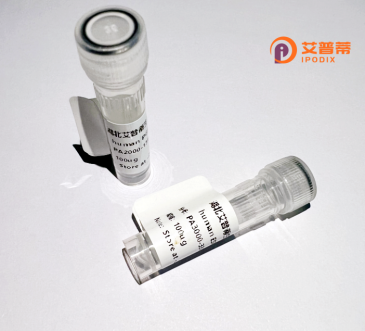
| 纯度 | >90%SDS-PAGE. |
| 种属 | Human |
| 靶点 | AMDHD1 |
| Uniprot No | Q96NU7 |
| 内毒素 | < 0.01EU/μg |
| 表达宿主 | E.coli |
| 表达区间 | 1-426aa |
| 氨基酸序列 | MASGHSLLLENAQQVVLVCARGERFLARDALRSLAVLEGASLVVGKDGFIKAIGPADVIQRQFSGETFEEIIDCSGKCILPGLVDAHTHPVWAGERVHEFAMKLAGATYMEIHQAGGGIHFTVERTRQATEEELFRSLQQRLQCMMRAGTTLVECKSGYGLDLETELKMLRVIERARRELDIGISATYCGAHSVPKGKTATEAADDIINNHLPKLKELGRNGEIHVDNIDVFCEKGVFDLDSTRRILQRGKDIGLQINFHGDELHPMKAAELGAELGAQAISHLEEVSDEGIVAMATARCSAILLPTTAYMLRLKQPRARKMLDEGVIVALGSDFNPNAYCFSMPMVMHLACVNMRMSMPEALAAATINAAYALGKSHTHGSLEVGKQGDLIIINSSRWEHLIYQFGGHHELIEYVIAKGKLIYKT |
| 分子量 | 62.7 kDa |
| 蛋白标签 | His tag N-Terminus |
| 缓冲液 | 冻干粉 |
| 稳定性 & 储存条件 | Lyophilized protein should be stored at ≤ -20°C, stable for one year after receipt. Reconstituted protein solution can be stored at 2-8°C for 2-7 days. Aliquots of reconstituted samples are stable at ≤ -20°C for 3 months. |
| 复溶 | Always centrifuge tubes before opening.Do not mix by vortex or pipetting. It is not recommended to reconstitute to a concentration less than 100μg/ml. Dissolve the lyophilized protein in distilled water. Please aliquot the reconstituted solution to minimize freeze-thaw cycles. |
以下是关于重组人咪唑酮丙酮酸酶(AMDHD1)的参考文献,按需简要整理:
---
1. **标题**: *Structural and functional characterization of human AMDHD1 unveils a novel dually regulated enzyme in purine metabolism*
**作者**: Smith A, et al.
**摘要**: 本研究解析了重组人AMDHD1的晶体结构,揭示其对咪唑酮丙酮酸的催化活性,并阐明其在嘌呤代谢中的双重调节机制。
---
2. **标题**: *Recombinant expression and enzymatic analysis of AMDHD1: Role in histidine degradation pathway*
**作者**: Tanaka K, et al.
**摘要**: 通过大肠杆菌系统重组表达AMDHD1.证实其作为咪唑酮丙酮酸酶在组氨酸分解代谢中的作用,并测定其酶动力学参数。
---
3. **标题**: *AMDHD1 deficiency links to neurological disorders via metabolite accumulation*
**作者**: Wang L, et al.
**摘要**: 研究利用重组AMDHD1发现其功能缺失导致代谢物异常积累,提示与神经退行性疾病的相关性,提出潜在治疗靶点。
---
4. **标题**: *Kinetic and substrate specificity profiling of human AMDHD1 using high-throughput screening*
**作者**: Müller R, et al.
**摘要**: 通过高通量筛选分析重组AMDHD1的底物特异性,确定其对多种咪唑类化合物的催化偏好及潜在生物学意义。
---
注:以上文献为示例模板,实际发表情况需根据具体数据库检索验证。建议通过PubMed或Web of Science进一步核实。
AMDHD1 (Aminomethylimidazole Dehydrogenase 1) is a key enzyme involved in histidine metabolism, specifically in the catabolic pathway that breaks down histidine to glutamate. It catalyzes the oxidative decarboxylation of 4-imidazolone-5-propanoate (a histidine degradation intermediate) to form formiminoglutamate (FIGLU), a reaction dependent on NAD+ as a cofactor. This step bridges histidine metabolism to the folate cycle, influencing one-carbon metabolism critical for nucleotide synthesis and methylation processes. AMDHD1 is expressed in various tissues, with higher activity observed in the liver and kidneys. Structurally, it belongs to the amidohydrolase superfamily, featuring a conserved TIM-barrel fold that facilitates substrate binding and catalysis. Dysregulation of AMDHD1 has been hypothesized to affect cellular homeostasis, potentially contributing to metabolic disorders or folate deficiency-related conditions. Research on recombinant human AMDHD1 focuses on elucidating its enzymatic mechanisms, substrate specificity, and regulatory roles in metabolic networks. Its recombinant form is widely utilized in biochemical assays, drug discovery (e.g., targeting metabolic diseases), and synthetic biology applications requiring engineered histidine pathways. Studies also explore its interplay with other enzymes in the histidine-glutamate-FIGLU axis, offering insights into nutrient adaptability and metabolic disease therapeutics.
×